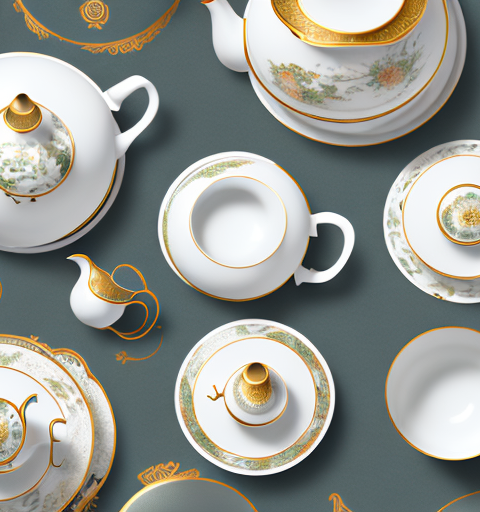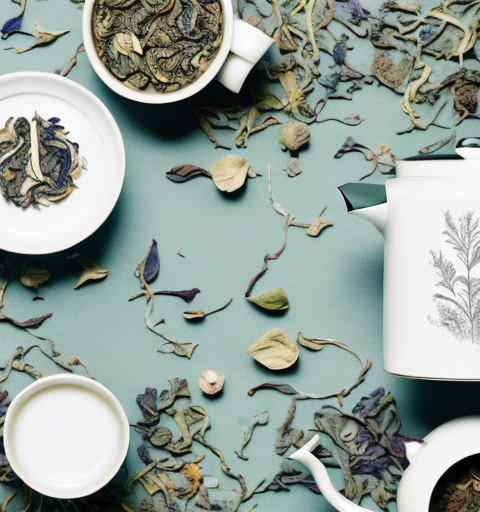When it comes to enjoying a comforting cup of tea, a teapot with a curved ceramic spout is a popular choice. However, over time, tea stains can accumulate on the surface of the spout, affecting its appearance and potentially impacting the taste of your tea. In this article, we will explore the cause of tea stains on ceramic spouts, the challenges of cleaning curved ceramic teapot spouts, effective techniques for removing tea stains, step-by-step cleaning guides, common mistakes to avoid, natural remedies, best cleaning products, tips for preventing tea stains, expert advice on maintenance, dealing with stubborn stains, the importance of regular cleaning, restoring shine and luster, and exploring alternative cleaning methods. So, let’s dive in and discover how to keep your ceramic teapot spout spotless and clean!
Understanding the Cause of Tea Stains on Ceramic Spouts
Tea stains on ceramic spouts are caused by the tannins present in the tea. Tannins are natural compounds found in tea leaves that can adhere to the porous surface of the ceramic. Over time, these stains can build up, resulting in discoloration and an unsightly appearance. It’s important to address these stains promptly to maintain the beauty and functionality of your teapot spout.
One effective way to remove tea stains from ceramic spouts is to use a mixture of baking soda and water. Create a paste by mixing equal parts baking soda and water, then apply it to the stained area. Gently scrub the paste onto the surface using a soft cloth or sponge. Rinse the spout thoroughly with water and dry it with a clean towel. This method can help remove stubborn tea stains and restore the original appearance of your ceramic spout.
The Challenges of Cleaning Tea Stains on Curved Ceramic Teapot Spouts
Cleaning tea stains on curved ceramic teapot spouts can be a bit more challenging compared to flat surfaces. The curved design of the spout can make it difficult to reach all areas and remove stubborn stains. Additionally, the delicate nature of ceramic requires extra care to prevent any damage during the cleaning process.
One effective method for cleaning tea stains on curved ceramic teapot spouts is to create a paste using baking soda and water. This paste can be applied to the stained areas and left to sit for a few minutes before gently scrubbing with a soft brush or sponge. The baking soda acts as a gentle abrasive, helping to lift the stains without causing any damage to the ceramic surface. After scrubbing, rinse the spout thoroughly with warm water to remove any residue. This method can be particularly useful for removing stubborn tea stains that have built up over time.
Effective Techniques for Removing Tea Stains from Ceramic Spouts
There are several effective techniques you can use to remove tea stains from ceramic spouts. One method involves creating a paste using baking soda and water. Apply this paste to the stain and gently scrub with a soft brush. Rinse thoroughly with warm water to reveal a clean spout. Another technique is to use a mixture of white vinegar and water. Soak a soft cloth in the vinegar solution and gently wipe the stained areas. Rinse with water and dry thoroughly.
Additionally, lemon juice can be used as a natural alternative for removing tea stains from ceramic spouts. Squeeze fresh lemon juice onto the stained areas and let it sit for a few minutes. Then, scrub the stains with a soft brush or sponge. Rinse with water and dry the spout thoroughly to prevent any residue.
If the tea stains are particularly stubborn, you can try using a commercial ceramic cleaner specifically designed for removing stains. Follow the instructions on the cleaner’s packaging and apply it to the stained areas. Gently scrub the stains and rinse thoroughly with water. Make sure to dry the spout completely to avoid any potential damage or discoloration.
Step-by-Step Guide: Cleaning Tea Stains from a Curved Ceramic Teapot Spout
1. Start by rinsing the teapot spout with warm water to remove any loose debris and prepare it for cleaning.2. Prepare a paste using baking soda and water. Apply the paste to the stained areas of the spout.3. Gently scrub the stained areas using a soft brush or toothbrush. Pay extra attention to the curved sections, ensuring that the paste reaches all the nooks and crannies.4. Rinse the spout thoroughly with warm water, removing all traces of the paste.5. Alternatively, you can use a mixture of white vinegar and water. Soak a soft cloth in the vinegar solution and gently wipe the stained areas of the spout.6. Rinse the spout with water to remove any lingering vinegar smell.7. Dry the teapot spout completely before using it again to prevent any moisture-related issues.8. Admire the clean and sparkling ceramic spout of your teapot!
Tea stains can be stubborn and may require additional steps for complete removal. If the baking soda paste or vinegar solution did not fully remove the stains, you can try using a specialized ceramic cleaner. Apply the cleaner to a soft cloth and gently scrub the stained areas of the spout. Rinse thoroughly with warm water afterwards.
For tough tea stains that have been left untreated for a long time, you may need to repeat the cleaning process multiple times or let the paste or solution sit on the stains for a longer period. Be patient and persistent in your cleaning efforts to achieve the desired results.
Common Mistakes to Avoid When Cleaning Tea Stains on Ceramic Spouts
While cleaning tea stains from ceramic spouts, it’s important to avoid certain mistakes that could potentially damage the surface. Avoid using harsh abrasive cleaners, as they can scratch the ceramic. Similarly, refrain from using metal brushes or scrubbers, as they can cause damage to the delicate surface of the spout. It’s also crucial not to use excessive force when scrubbing, as this can lead to chipping or cracking of the spout.
Another mistake to avoid when cleaning tea stains on ceramic spouts is using bleach or other strong chemicals. These can not only damage the surface of the spout but also leave behind harmful residues that can contaminate your tea. Instead, opt for gentle cleaning solutions specifically designed for ceramic surfaces.
In addition, it’s important to avoid soaking the ceramic spout for extended periods of time. While it may seem like a good idea to let the spout soak in a cleaning solution to loosen stubborn stains, prolonged exposure to liquids can weaken the ceramic and cause it to become more susceptible to cracks or breakage. Instead, try using a soft cloth or sponge to gently scrub the stained area.
Natural Remedies to Remove Tea Stains from Ceramic Teapot Spouts
If you prefer natural remedies, there are a few options to explore for removing tea stains from ceramic teapot spouts. Lemon juice and salt can be mixed into a paste and applied to the stained areas. The citric acid in lemon juice helps break down the tea stains, while the salt acts as an abrasive. Another natural option is using a solution of hydrogen peroxide and baking soda. Apply this mixture to the stains, gently scrub, and rinse thoroughly for clean results.
Additionally, white vinegar can be used as a natural remedy to remove tea stains from ceramic teapot spouts. Simply soak a cloth or sponge in white vinegar and gently scrub the stained areas. The acetic acid in vinegar helps to dissolve the tea stains, leaving your teapot spouts clean and shiny.
For stubborn tea stains, you can try using a mixture of baking soda and water. Create a paste by combining the two ingredients and apply it to the stained areas. Let it sit for a few minutes, then scrub gently with a soft brush or sponge. Rinse thoroughly to remove any residue and enjoy your tea stain-free teapot spouts.
Best Cleaning Products for Removing Tea Stains on Curved Ceramic Spouts
If you’re looking for cleaning products specifically designed to tackle tea stains on curved ceramic spouts, there are numerous options available. Look for products that are gentle yet effective. Some specialized cleaning solutions for ceramic surfaces can be found in supermarkets or online retailers. Make sure to follow the instructions provided by the manufacturer for optimal results.
One popular cleaning product for removing tea stains on curved ceramic spouts is a vinegar and water solution. Mix equal parts white vinegar and water in a spray bottle and apply it to the stained area. Let it sit for a few minutes, then scrub gently with a soft brush or sponge. Rinse thoroughly with water and dry with a clean cloth.
Another effective option is a baking soda paste. Mix baking soda with a small amount of water to create a thick paste. Apply the paste to the stained area and let it sit for about 15 minutes. Scrub gently with a soft brush or sponge, then rinse with water and dry with a clean cloth. Baking soda is known for its natural cleaning properties and can help remove stubborn tea stains.
Tips for Preventing Tea Stains on Ceramic Teapot Spouts with a Curved Design
Prevention is often the best strategy when it comes to tea stains on ceramic teapot spouts. By implementing a few simple tips, you can minimize the likelihood of stains developing in the first place. One preventive measure is to rinse the teapot spout immediately after each use. This helps remove any residual tea and prevents it from drying on the surface. Another tip is to periodically deep clean your teapot to remove any buildup before stains have a chance to form.
Additionally, using a soft brush or sponge specifically designed for cleaning teapot spouts can help to gently scrub away any stubborn stains that may have already formed. It is important to avoid using abrasive materials or harsh chemicals, as these can damage the ceramic surface of the teapot. Regularly inspecting the spout for any signs of discoloration or staining and addressing them promptly can also help to prevent the stains from becoming more difficult to remove over time. By following these tips, you can keep your ceramic teapot spout with a curved design looking clean and stain-free for longer.
Expert Advice: How to Maintain a Spotless Ceramic Teapot Spout with a Curved Design
To maintain a spotless ceramic teapot spout, it’s important to adhere to a proper cleaning and maintenance routine. Regularly clean your spout using the techniques mentioned earlier to prevent stains from becoming deeply embedded. Additionally, always store your teapot in a dry place to avoid moisture-related issues. If you notice any deep or stubborn stains, consider seeking expert advice or professional cleaning services for guidance on the best course of action.
Furthermore, it is recommended to avoid using abrasive cleaning tools or harsh chemicals on the ceramic teapot spout, as these can cause damage or discoloration. Instead, opt for gentle cleaning solutions such as mild dish soap and warm water. Additionally, be cautious when handling the teapot, especially if it has a curved design, as the spout may be more delicate and prone to breakage. By following these tips and taking proper care of your ceramic teapot spout, you can ensure its longevity and keep it looking spotless for years to come.
Troubleshooting: Dealing with Stubborn Tea Stains on Curved Ceramic Spouts
In some cases, stubborn tea stains may require additional attention. If you’ve tried various cleaning methods and the stains persist, there are a few troubleshooting steps you can take. Soaking the spout in a mixture of warm water and dish soap can help loosen stubborn stains. Alternatively, using a diluted solution of bleach and water can be effective, but remember to take necessary precautions and follow safety guidelines when working with bleach. However, it’s important to always test any cleaning solution on a small, inconspicuous area of the spout first to ensure it doesn’t cause any adverse effects.
If soaking and using cleaning solutions do not remove the stubborn tea stains, you can try using a soft-bristled toothbrush or a cotton swab to gently scrub the affected area. Be careful not to apply too much pressure, as this can damage the ceramic surface. Additionally, you can try using a paste made from baking soda and water, which can act as a mild abrasive to help lift the stains.
If all else fails, you may need to consider professional cleaning services. There are specialized companies that offer ceramic restoration services, which can effectively remove stubborn stains and restore the spout to its original condition. However, keep in mind that professional cleaning services may come at an additional cost and may not be necessary for minor stains.
The Importance of Regularly Cleaning and Maintaining Your Teapot’s Ceramic Spout
Maintaining a clean and stain-free ceramic teapot spout is not just about aesthetics – it’s also crucial for ensuring the longevity and functionality of your teapot. Tea stains can accumulate over time and compromise the taste of your tea. Additionally, if left untreated, stains can become more difficult to remove, potentially leading to permanent discoloration. By regularly cleaning and maintaining your teapot’s ceramic spout, you can enjoy a cup of tea with a spotless and pristine spout every time.
How to Restore the Shine and Luster of a Tea-stained Ceramic Teapot Spout
If your tea-stained ceramic teapot spout has lost its shine and luster, there are a few steps you can take to restore its beauty. Start by cleaning the spout using the methods mentioned earlier to remove the tea stains. Afterward, rinse thoroughly and dry the spout. Once dry, you can polish the ceramic surface using a microfiber cloth or a ceramic-specific polish. Gently buff the surface in circular motions to restore its shine and luster. Take care not to apply excessive pressure that could potentially damage the surface of the spout.
Exploring Alternative Methods for Removing Tea Stains from Curved Ceramic Teapot Spouts
In addition to the traditional cleaning methods mentioned earlier, there are several alternative methods you can explore to remove tea stains from curved ceramic teapot spouts. Some tea enthusiasts have found success using denture cleaning tablets dissolved in warm water. Simply soak the teapot spout in the solution for a few hours, rinse thoroughly, and enjoy a clean spout. Another alternative method is using a mixture of baking soda and hydrogen peroxide. Apply the paste to the stained areas, let it sit for some time, then scrub and rinse for a refreshed spout.
DIY vs Professional Cleaning: What’s the Best Option for Your Teapot’s Ceramic Spout?
When it comes to cleaning tea stains from your teapot’s ceramic spout, you might be wondering whether to opt for a DIY approach or seek professional cleaning services. The decision depends on various factors such as the severity of the stains, personal preference, and time constraints. For mild to moderate stains, a DIY approach using the techniques mentioned earlier should suffice. However, if you’re dealing with deep-set or stubborn stains, or if you simply prefer expert assistance, considering professional cleaning services might be the best option. Professionals can offer specialized tools, techniques, and knowledge to ensure effective stain removal without compromising the integrity of your teapot spout.
With the comprehensive information provided in this article, you now have all the knowledge and techniques at your disposal to tackle tea stains on the ceramic spout of your teapot with a curved design. Remember to follow the step-by-step guide, avoid common mistakes, consider natural remedies, use appropriate cleaning products, implement preventive measures, seek expert advice when needed, troubleshoot stubborn stains, prioritize regular cleaning and maintenance, restore shine and luster, and explore alternative methods for stain removal. By incorporating these tips and techniques into your tea-stained ceramic teapot spout care routine, you can ensure that your teapot remains a beautiful and functional centerpiece for your tea ritual.






